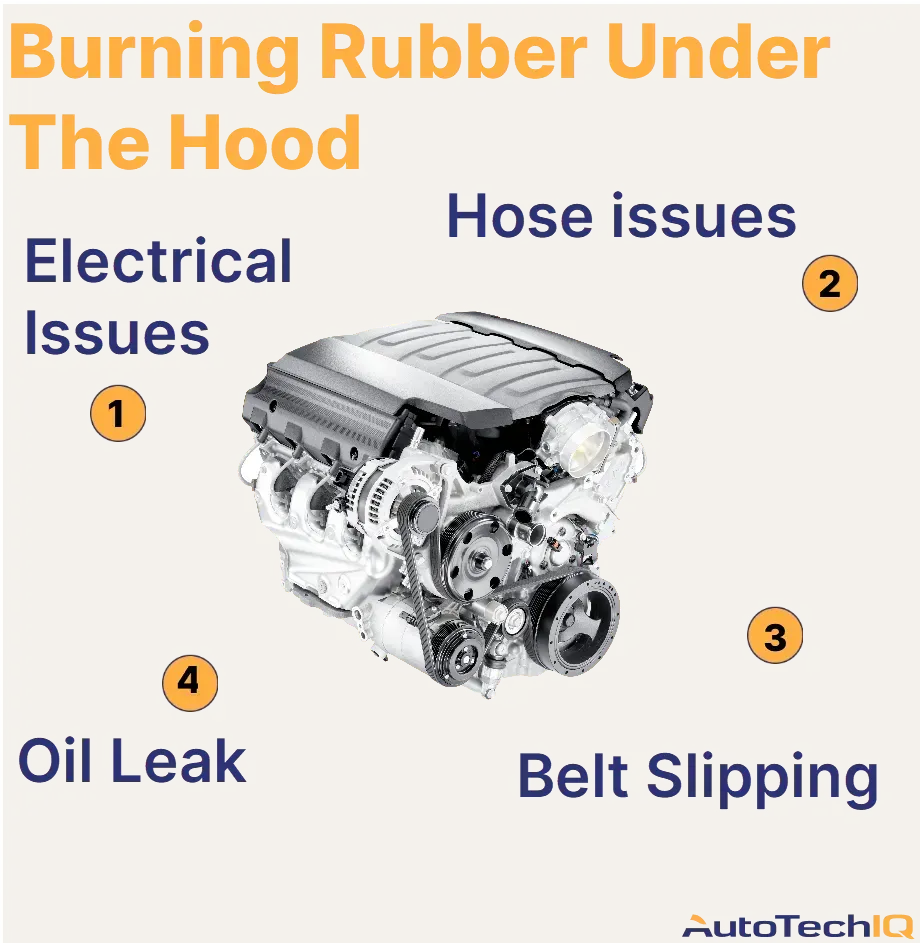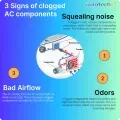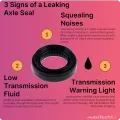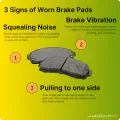

Your car smells like burning rubber under the hood because some underhood rubber components are overheating and burning. There are plenty of hoses, valves, belts, etc. that can either slip out of place or receive too much heat from leaks, causing burning rubber smells.
Watch out: The burning rubber smell often means that a problem is progressing. If you smell burning rubber under your vehicle's hood, components might be at risk, which means problems in your car's engine, electrical, steering, or even transmission systems. The problem can quickly cause a critical situation mid-traffic.
A burning rubber smell coming from under the hood of your car can indicate several potential safety risks, including:
-
Engine Overheating: If a belt or hose is malfunctioning, it can lead to engine overheating. An overheated engine can cause severe damage and potentially lead to a fire. You might also smell burning oil in this case due to oil burning on hot engine components.
-
Fire Hazard: Oil leaks, electrical shorts, or melting hoses can pose a significant fire risk. Any time there’s a burning smell, there’s a potential for a fire to ignite within the engine compartment.
-
Loss of Power Steering: A failing serpentine belt can affect the power steering system, making the vehicle difficult to steer and increasing the risk of an accident.
-
Brake Failure: If the burning smell is related to the brakes, such as dragging brake pads or a seized caliper, it can compromise braking efficiency and increase stopping distances, posing a serious safety risk.
The most common causes for a burning rubber smell from under the hood
-
Belt Slippage (Serpentine belt): If a belt (like the serpentine belt) is slipping, it can generate heat and cause a burning rubber smell. This is often due to the belt being worn out, loose, or misaligned.
-
Melted car hoses: A hose that is damaged or touching a hot component (like the engine or exhaust) can start to melt and produce a burning rubber smell. Inspect hoses for signs of wear or melting.
-
Oil Leak: If oil is leaking onto hot engine parts, it can produce a smell similar to burning rubber. Check for oil leaks and inspect areas around the valve cover gasket and oil pan. You'll probably also notice a burning oil smell.
-
Electrical Issues: Worn or frayed electrical wiring can sometimes cause a burning smell if the wires are overheating or shorting out. This can be particularly dangerous and should be addressed immediately.
- Faulty tensioner: A failed tensioner can cause a burning rubber smell in a car due to the increased friction and heat generated by a loose or misaligned serpentine belt. The tensioner maintains the proper tension of the serpentine belt, if it fails, it'll generate extra friction, causing the burning smell.
- Friction on the timing cover: Friction on the timing cover can cause a burning rubber smell in a car due to the rubbing of the timing belt or chain against the cover. This friction can generate heat and cause the belt or chain to deteriorate, emitting a burning rubber smell.
Frequently Asked Questions
Should I drive my car if it smells like burning rubber?
No, it's best to avoid driving your car if it smells like burning rubber. This smell indicates friction and overheating of rubber components, which could be brakes, belts, or a clutch. Continued driving could worsen the issue and potentially lead to a breakdown or even a fire. Pull over to a safe location, turn off the engine, and if you can't identify the cause yourself, call a mechanic for a proper diagnosis.
Why does my car smell like burning rubber but isn't overheating?
Even without overheating, a burning rubber smell likely means friction is causing a rubber component to overheat under the hood. This could be brakes from excessive use, a slipping serpentine belt due to wear or misalignment, a worn clutch in a manual car, or even leaking engine oil that's burning in hot engine parts. Pull over safely, turn off the engine, and get it inspected by a mechanic to avoid further damage or potential safety hazards.
Does a bad transmission smell like burning rubber?
Yes, a bad transmission can emit a burning rubber smell. When transmission fluid overheats due to low fluid levels, worn components, or internal problems, it can burn and give off this odor. This is a warning sign of potential transmission damage. If you smell burning rubber, pull over and shut off the engine. You might want to check under the car, noticing the exhaust system and exhaust pipe to search for any oil leak. Don't drive it further and call a mechanic for inspection.
Typical fixes to address the cause(s)
These are typical processes and repair services that fix a burning rubber issue from under the hood:
The most common cause: Belt slipping
The main culprits of a burning rubber smell from under a vehicle's hoods are the rubber belts running in that area. There are vehicles with a higher number of belts under the hood.
These belts are typically rubber, running along one or more pulleys, where they rotate and power specific vehicle systems. As these belts rotate, they can wear out or slip out of place due to time, impact, or vibrations.
Since these belts are next to some high-heat engine and electrical components, they might rub against overheating parts after slipping out of place. As a result, they burn or melt, causing a burning rubber smell.
What exactly are these belts?
Commonly, these are the belts under most vehicle's hoods:
-
Serpentine Belt: This is a long, winding belt that drives multiple peripheral devices in an engine, such as the alternator, power steering pump, water pump, air conditioning compressor, and sometimes the radiator fan. It's called a serpentine belt because of its winding, snake-like path around the various pulleys.
-
Timing Belt: This belt synchronizes the rotation of the crankshaft and the camshaft, ensuring that the engine's valves open and close at the proper times during each cylinder's intake and exhaust strokes. Not all vehicles have timing belts; some use timing chains instead.
-
V-Belt: These are older-style belts that may be found in older vehicles or in certain systems. V-belts are typically shorter and only drive one or two components, such as the alternator or power steering pump. Vehicles with multiple V-belts usually have separate belts for each accessory.
-
Drive Belt: This is a general term that can refer to any belt that drives engine accessories. In modern vehicles, this is typically the serpentine belt, but it can also refer to V-belts in older vehicles.
Each of these belts plays a crucial role in the operation of your vehicle's engine and its various systems. Regular inspection and maintenance of these belts are important to ensure they are in good condition and to prevent unexpected failures.
Go safe: If you're feeling a burning rubber smell from under the hood, have a mechanic look at it quickly. If one of the aforementioned belts is faulty, your vehicle might break down unexpectedly and put you in risky situations. Many shops do inspections to track the burning smell and find the issue's urgency.
What’s a vehicle inspection? It’s “detective work” on your vehicle, checking its systems to find if anything is preventing the car from working as expected. In this case, mechanics examine different parts under your vehicle's hood to track where the burning smell is coming from and what’s causing it. They’ll also check the condition of components during their inspection, noting which caused the problem and which got affected by it, recommending to replace them in order of priority.
Transparency example in an underhood belt inspection
Let's see how a vehicle inspection focused on investigating a burning rubber smell under the hood goes in a transparent shop.
In this example, the technician found an issue with the timing belt. They discovered that the belt's cover was bent out of place and rubbing against the timing belt, causing friction and burns.
The timing cover is a component that works adjacent to the engine, acting as a protective housing. The timing cover protects the timing belt, a sort of chain that rotates with gears and synchronizes engine components to run the combustion process.
The timing belt cover is typically made of metal or plastic and works close to extreme temperatures. Over time, the timing cover can weaken and start melting, producing a burning rubber or plastic smell.

This is a "silent" type of issue since the smell doesn't accompany noises. In the example above, the only symptom noticed by the driver was the strange odor. Unfortunately, tracking this type of problem isn't easy; the best approach is to take your car for an inspection.
Letting this progress would have cost the car's engine. Fortunately, the client was quick to visit an auto shop.
In this case, the mechanic put the "Immediate Action" label on the timing cover and belt, indicating that they're the vehicle's current priority.
Other news
-
Car is Squealing When Driving

-
What is Preventative Maintenance and What Are The Benefits of it?

-
JobViewIQ - DVI Process Training - Part of the Auto Care Alliance Benefits

-
7 Signs of Clogged AC Components

-
How Much Does a Transmission Fluid Change Cost?

-
7 Signs of a Leaking Axle Seal

-
8 Signs of a Bad Brake Pad
